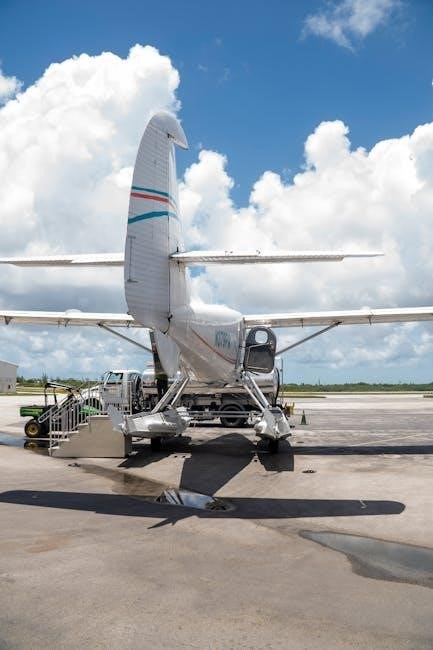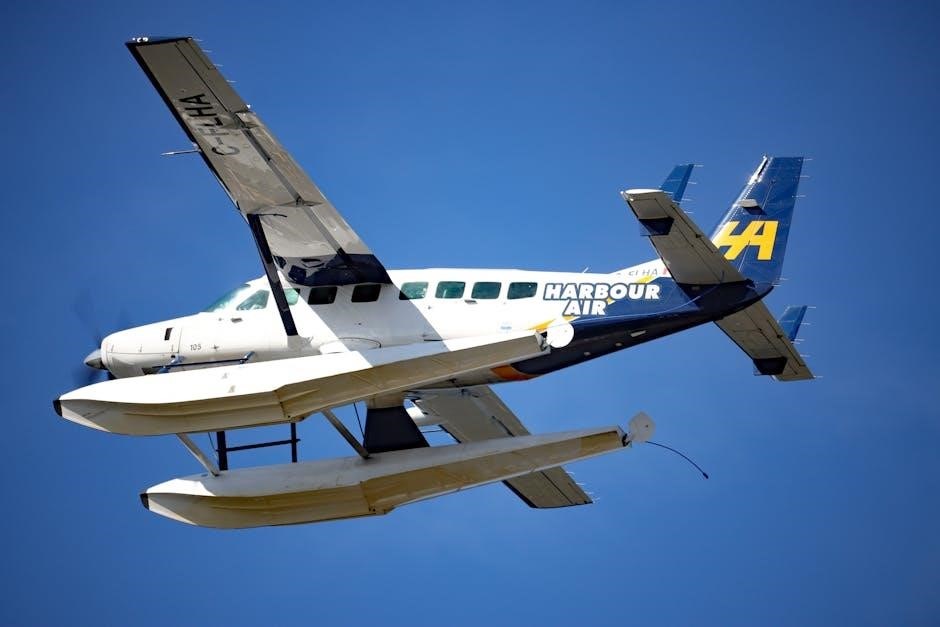cessna 172n poh pdf
The Pilot’s Operating Handbook (POH) for the Cessna 172N is a comprehensive guide designed to help pilots operate the aircraft safely and effectively. It includes detailed sections on normal procedures‚ performance specifications‚ and emergency protocols‚ ensuring pilots understand the aircraft’s capabilities and limitations. The POH is essential for mastering the Cessna 172N and adhering to FAA regulations.
Purpose and Structure of the Pilot’s Operating Handbook
The Cessna 172N POH serves as a detailed guide for pilots‚ providing essential information on aircraft operation‚ performance‚ and safety. Organized into clear sections‚ it covers normal procedures‚ emergency protocols‚ and maintenance requirements‚ ensuring pilots can operate the aircraft safely and efficiently. Its structured format makes it a vital resource for all flight operations.
Key Features of the Cessna 172N Model
The Cessna 172N is a single-engine‚ four-seat aircraft known for its durability and reliability. It features a Lycoming O-320-H2AD engine‚ retractable landing gear‚ and a robust airframe. Its design emphasizes stability and ease of handling‚ making it an ideal trainer and personal aircraft. The model also includes advanced avionics and safety features for enhanced performance.
Airspeed and Weight Limitations
The Cessna 172N has defined airspeed and weight limits for safe operation. Maximum airspeed is 155 knots‚ while the maximum takeoff weight is 2‚550 pounds‚ ensuring optimal performance and safety.
Maximum and Minimum Airspeeds for Safe Operation
The Cessna 172N has a maximum airspeed of 155 knots (IAS) and a never-exceed speed of 160 knots. Minimum airspeed for steady flight is 43 knots‚ with a stall speed of 48 knots at maximum weight. Adhering to these limits ensures safe and controlled flight operations under various conditions.
Weight Limits and Loading Configurations
The Cessna 172N has a maximum gross weight of 2‚550 pounds‚ with a useful load of 764 pounds. Proper weight distribution is critical to maintain the aircraft’s center of gravity within safe limits. Pilots must ensure all cargo and passengers are loaded correctly to avoid exceeding structural limits and maintain safe flight dynamics.

Normal Operating Procedures
Normal operating procedures for the Cessna 172N include pre-flight inspections‚ startup‚ taxi‚ takeoff‚ cruise‚ and landing protocols. These procedures ensure safe and efficient operation of the aircraft under standard conditions.
Pre-Flight Inspection Checklist
The pre-flight inspection checklist for the Cessna 172N ensures safety by verifying aircraft readiness. Pilots inspect control surfaces‚ tires‚ oil levels‚ fuel quantity‚ and instruments. The checklist also includes cabin and cockpit checks‚ such as seat belts‚ avionics‚ and flight controls‚ to guarantee all systems are functional before takeoff.
Start-Up and Taxi Procedures
Start-up involves ensuring the mixture is lean‚ engaging the starter‚ and priming as needed. Taxi procedures require using brakes and partial power to maintain directional control. Pilots must check for obstructions‚ use taxiway signs‚ and keep speed minimal to avoid skidding or losing traction‚ ensuring safe ground movement before takeoff.
Takeoff and Climb Techniques
For takeoff‚ advance the throttle smoothly to full power‚ maintaining centerline alignment. Once airborne‚ retract flaps at 400 AGL and set climb speed (70-80 KIAS). Monitor instruments for proper performance. During climb‚ maintain heading and adjust pitch as needed to stay on course and ensure a steady ascent to desired altitude.
Cruise‚ Descent‚ and Landing Procedures
During cruise‚ maintain desired altitude and adjust power for fuel efficiency. For descent‚ configure flaps as needed and control sink rate. Landing involves aligning with the runway‚ following the checklist‚ and ensuring a smooth touchdown. Proper techniques ensure safety and adherence to standard operating procedures.

Emergency Procedures
The Cessna 172N POH outlines critical steps for handling emergencies‚ including engine failure‚ system malfunctions‚ and emergency landings. These procedures ensure pilot preparedness and safe outcomes in critical situations.
Engine Failure and Restart Procedures
In the event of engine failure‚ the Cessna 172N POH guides pilots to maintain aircraft control‚ secure the engine‚ and attempt a restart if conditions permit. Restart procedures include checking fuel flow‚ ignition‚ and priming. If unsuccessful‚ pilots should notify ATC‚ configure for landing‚ and prepare for an emergency landing at the nearest suitable location.
System Malfunctions and Recovery Techniques
The Cessna 172N POH outlines procedures for handling system malfunctions‚ such as electrical or hydraulic issues. Pilots are advised to identify the problem‚ isolate affected systems‚ and use backup systems if available. Recovery techniques include resetting circuit breakers‚ switching to alternate power sources‚ and completing necessary checks before continuing flight operations safely.
Emergency Landing Protocols
The Cessna 172N POH provides detailed emergency landing protocols to ensure pilot and passenger safety. Procedures include securing the engine‚ transmitting distress signals‚ and preparing the cabin for impact. Pilots must follow checklist steps meticulously‚ maintaining control of the aircraft to minimize damage and risk. Proper execution of these protocols is critical for successful outcomes in emergency situations.

Performance Specifications
The Cessna 172N delivers exceptional performance with a maximum speed of 141 knots at sea level and a service ceiling of 13‚100 feet‚ ensuring versatility for various flight missions.
Speed and Range Capabilities
The Cessna 172N achieves a maximum speed of 141 knots at sea level and 124 knots at 8‚000 feet. Its range is approximately 795 nautical miles with a standard fuel capacity of 53 gallons‚ making it ideal for cross-country flights while balancing efficiency and performance.
Climb and Ceiling Performance
The Cessna 172N climbs at a rate of 720 feet per minute‚ reaching a service ceiling of 13‚500 feet. This performance enables pilots to efficiently ascend to optimal altitudes for fuel economy‚ comfort‚ and weather avoidance‚ making the aircraft versatile for both training and recreational flying missions.
Fuel Consumption and Efficiency
The Cessna 172N burns approximately 8-9 gallons of 100/130 grade aviation fuel per hour at cruise speeds. With a total fuel capacity of 53 gallons‚ it offers an endurance of 5.5 hours. Proper fuel management and leaning techniques‚ as outlined in the POH‚ optimize efficiency and ensure safe operation across various flight conditions.
Maintenance and Service Requirements
Regular maintenance and inspections are crucial for the Cessna 172N’s safety and performance. Adhere to scheduled service intervals‚ use approved tools‚ and follow manufacturer guidelines. Ensure proper fuel grade and tire pressure for optimal operation.
Regular Maintenance Schedule
Regular maintenance for the Cessna 172N includes routine inspections‚ lubrication‚ and battery checks. Ensure tire pressure meets specifications (31 PSI for nose wheel) and fuel grade is 100LL. Follow FAA guidelines for periodic inspections and document all services to maintain compliance and ensure optimal performance.
Service Intervals and Inspection Criteria
The Cessna 172N requires regular inspections at 100-hour intervals and annual inspections. Inspect control surfaces‚ engine oil‚ and filters‚ ensuring compliance with FAA standards. Spark plugs should be serviced every 50 hours‚ and all maintenance must be documented in logbooks to maintain airworthiness and safety.
Recommended Tools and Equipment
Essential tools include wrenches‚ screwdrivers‚ pliers‚ and tire pressure gauges. Specialized tools like torque wrenches and multimeters are also required. Safety equipment such as fire extinguishers and first aid kits should be onboard. Always refer to the POH for a detailed list of necessary tools and equipment for maintenance and operation.

Supplements and Optional Equipment
This section provides an overview of approved modifications‚ optional avionics‚ and additional safety features available for the Cessna 172N. These upgrades enhance performance‚ functionality‚ and safety‚ varying by model year and manufacturer approvals.
Approved Modifications and Upgrades
The Cessna 172N allows for various approved modifications to enhance performance‚ functionality‚ and safety. These include engine upgrades‚ avionics installations‚ and structural improvements‚ all requiring FAA certification. Modifications must comply with specific STCs and manufacturer guidelines to maintain airworthiness and safety standards‚ ensuring optimal aircraft operation and compliance with regulations.
Optional Avionics and Navigation Systems
The Cessna 172N POH outlines optional avionics and navigation systems‚ such as advanced GPS‚ autopilot‚ and digital instrument panels‚ to enhance flight precision and safety. These systems‚ when installed‚ must meet FAA standards and be documented in the airplane’s records. They are designed to improve situational awareness and reduce pilot workload during various flight conditions.
Additional Safety Features
The Cessna 172N POH highlights additional safety features such as emergency landing protocols‚ fire suppression systems‚ and specialized safety equipment. These features are designed to enhance pilot and passenger safety‚ aligning with the POH’s comprehensive guidelines for safe aircraft operation.
Legal and Regulatory Requirements
The Cessna 172N POH emphasizes compliance with FAA regulations‚ including mandatory documentation‚ maintenance records‚ and pilot certification standards. Adherence ensures legal operation and safety‚ aligning with federal aviation guidelines.
Compliance with FAA Regulations
The Cessna 172N POH requires strict adherence to FAA regulations‚ including airworthiness directives‚ maintenance standards‚ and pilot certification. Compliance ensures legal operation‚ with detailed guidelines for documentation‚ inspections‚ and flight procedures. Adhering to these regulations is essential for safe and lawful aircraft operation.
Mandatory Documentation and Record-Keeping
The Cessna 172N POH requires maintaining accurate records‚ including the airplane log‚ engine log‚ and pilot qualification documents. Regular updates and inspections must be documented to ensure compliance with FAA standards. Proper record-keeping is essential for tracking maintenance‚ airworthiness‚ and operational history‚ ensuring transparency and accountability in aircraft management.
Pilot Qualification and Training Requirements
Pilots must meet FAA requirements‚ holding a valid Private Pilot Certificate with appropriate ratings. Recurrent training is essential to maintain proficiency. The POH emphasizes adherence to these standards‚ ensuring pilots are qualified to operate the Cessna 172N safely and effectively. Compliance with these requirements is mandatory for legal and safe flight operations.
The Cessna 172N POH is an essential resource for safe and effective aircraft operation. By mastering its guidelines‚ pilots ensure compliance with regulations and optimal flight practices‚ fostering confidence and proficiency in the skies.
The Cessna 172N POH is a vital resource for pilots‚ providing essential information on safe operation‚ performance‚ and legal compliance. It covers critical aspects like airspeed limitations‚ weight restrictions‚ emergency procedures‚ and maintenance requirements. Adhering to the POH ensures pilots can maximize the aircraft’s capabilities while maintaining safety and regulatory compliance.
Final Tips for Safe and Effective Operation
Always thoroughly understand the Cessna 172N POH and adhere to its guidelines. Maintain situational awareness‚ follow pre-flight and post-flight checklists‚ and stay updated on aviation regulations. Regular aircraft inspections and proper fuel management are crucial. Make informed decisions based on weather and aircraft performance. Continuous training and a focus on safety culture ensure effective operation.
